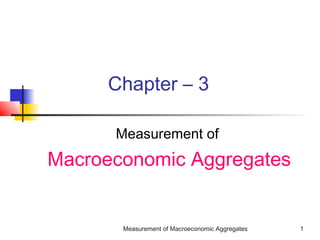
ECONOMICS Chapter 3
- 1. Measurement of Macroeconomic Aggregates 1 Chapter – 3 Measurement of Macroeconomic Aggregates
- 2. Measurement of Macroeconomic Aggregates2 Objectives of the Session To understand the concept of National Product To know about the eight variants of National Product Aggregates To understand real and nominal GNP To understand price indices To understand index number of production To know about money and credit To know about the measurement and uses of national income
- 3. Measurement of Macroeconomic Aggregates3 Introduction Economics analysis deals with those concepts which can actually be measured like price of industrial production, stock prices, interest rates etc. The concepts like national income and product are most significant in macroeconomic accounting.
- 4. Measurement of Macroeconomic Aggregates4 The Concept of The National Product The GDP growth rate, the most important indicator of the nation’s economy. GNP and national income provide the policy makers and business community with the most useful tool for analyzing an economy’s performance. In general, GNP is the sum of all final goods and services produced during a specific time period. When measuring GNP, or any other aggregate of national product, we are interested in the final value of goods and services.
- 5. Measurement of Macroeconomic Aggregates5 Relationship among Eight Variants of National Product Aggregates - net income from abroad -depreciation =NDPMP =NNPFC GDPMP GNPMP =NNPMP =NDPFC =GDPFC =GNPFC - net income from abroad -net indirect taxes -depreciation -depreciation- net income from abroad -net indirect taxes -net indirect taxes -depreciation -net indirect taxes - net income from abroad
- 6. Measurement of Macroeconomic Aggregates6 Real vs. Nominal GNP Real GNP is the GNP in current rupees deflated for changes in the prices of the items included in GNP. Nominal GNP expresses in current rupees. It measures the value of output in a given period in the prices of that period, or as it is sometimes put , in current rupees.
- 7. Measurement of Macroeconomic Aggregates7 Price Indices The Consumer Price Index (CPI) It depends upon the Cost of Living Index (CLI) The Whole Sale Price Index National Income Deflators
- 8. Measurement of Macroeconomic Aggregates8 Index Number of Production Among the commonly used economic indictors to monitor current trends in the economy are indices of production. The index number of industrial production which is regularly published in “Monthly Statistics of production of Selected Industries” is a quantity index which cover mining; manufacturing; and electricity generation.
- 9. Measurement of Macroeconomic Aggregates9 In any modern economy, the quantity of money, aggregate volume of credit and its Sectoral composition are important variables. They have significant influence on expenditure flows such as consumption, investment etc. Money and Credit
- 10. Measurement of Macroeconomic Aggregates10 Definition: Money Stock Measures The RBI has evolve four measures of money denoted M1, M2, M3 and M4. They are as: M1: RBI currency notes with public + small coins + demand deposits with banks + other deposits with RBI M2: M1+ Post Office Savings Deposits M3: M1+ Time Deposits with banks M4: M3+ All Post Office Deposits (savings and time)
- 11. Measurement of Macroeconomic Aggregates11 The Measurement of National Income The Output Method The Expenditure Method The Income Method
- 12. Measurement of Macroeconomic Aggregates12 The Output Method It is followed either by valuing all the final goods and services produced during a year or by aggregating the values imparted to the intermediate products at each stage of production by the industries and productive enterprises in the economy. The sum of these values added gives the gross domestic product at factor cost.
- 13. Measurement of Macroeconomic Aggregates13 The Expenditure Method It aggregates all money spent by private citizens, firms and the government within the year, to obtain total domestic expenditure at market prices. This includes consumer spending and investment i.e. total domestic spending. It aggregates only the value of final purchases and excludes all expenditures on intermediate goods.
- 14. Measurement of Macroeconomic Aggregates14 The Income Method It aggregates only those of that residents of the nation, corporate and individual, that obtain income directly from the current production of goods and services. It aggregates the money payment made to different factors of production. The total of all factor of income gives total domestic income.
- 15. Measurement of Macroeconomic Aggregates15 Other Measures of National Output Gross national product Net national product National income Personal income Disposable income
- 16. Measurement of Macroeconomic Aggregates16 Five Alternative Measures of Income Depreciation Net Indirect Taxes Personal Taxes Personal Savings Net Export (E-M) Consumer Expenditure (C) Gross Private Domestic Investment (I) Government Purchases (G) Wages Proprietors Income Interest Rents Corporate Profit Minus Corporate profits and security insurance taxes Plus Transfer Payments, net Interest and Dividends Gross National Product GNPMP Net National Product NNPMP National Income NNPFC Personal Income Disposable Personal Income Personal Consumption
- 17. Measurement of Macroeconomic Aggregates17 Difficulties in Measuring National Income Non-market Production Imputed Values The Underground Economy “Side Effects” and Economic “Bads” Leisure and Human Costs Double Counting
- 18. Measurement of Macroeconomic Aggregates18 The Uses of National Statistics As an instrument of economic planning and review As a means of indicating changes in a country’s standard of living To indicate changes in economic growth of a country As a means of comparing the economic performance of different countries